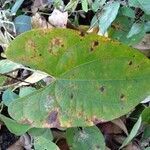Tubers usually 4--10, produced from apical branches of rhizome; cork light yellow, smooth; thorny roots present or absent. Stem twining to left, with T-shaped, soft hairs, proximally prickly, distally so only at nodes. Leaves alternate, simple; petiole 5--8 cm; leaf blade broadly cordate, to 15 × 17 cm, with T-shaped hairs especially abaxially, basal veins 9--13, base cordate, apex acute. Male spike solitary, dense, ca. 15 cm. Male flowers: usually solitary, rarely in cymules of 2--4, sessile or subsessile; bract ovate; perianth shallowly cupular, puberulent, outer lobes broadly lanceolate, ca. 1.8 mm, inner ones slightly shorter than outer; stamens 6, inserted in perianth tube, slightly shorter than perianth lobes. Female spike solitary, pendent, to 40 cm. Capsule very seldom maturing, ca. 3 cm, base truncate, apex slightly emarginate; wings ca. 1.2 cm wide. Seeds inserted near middle of capsule, winged all round. Fl. early summer.
A yam which has a spiny vine. It is a prickly climber. It can climb 1.2-2.4 m high and spread 1.8 m across. The vine twines to the left. The leaves are round with a gap where the leaf stalk joins. They are almost heart shaped. The leaf is about 12 cm long. This yam produces a cluster (5-20) of tubers under the ground. In many varieties there are sharp thorns just under the ground. In China forms occur without these spines. Often the tubers are sticky when cut. Many kinds occur. The flowers are green, 4 mm across and borne on long slender spikes. These are singly in the axils of leaves. There are many cultivated varieties and these vary in quality around the world.
With numerous (up to 40) stalked edible tubers independent of each other.
Spiny climber 30-40 ft. high
Lacking bulbils

